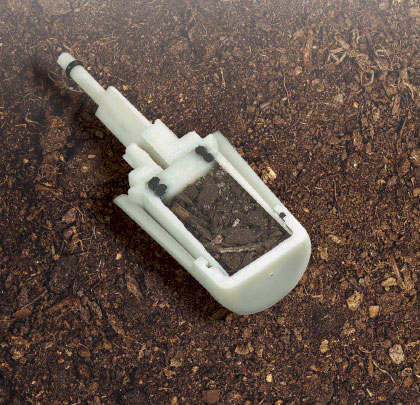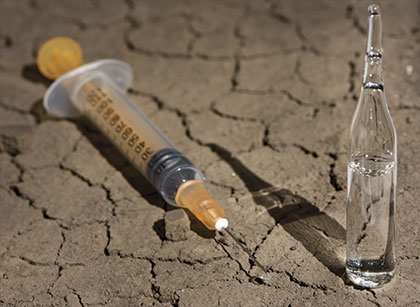In all types of environmental testing, using proper sample collection methods is vitally important, as the data analyzed in the laboratory is only as good as the quality of samples collected in the field. Soil testing and sampling is no different than any other kind of environmental testing in this regard. Collecting soil samples by the correct methods is the only way to get accurate, usable data. When collecting soil samples to test for volatile organic compounds (VOCs), every action performed from the time that the soil cores are collected to the preparation of the samples for shipment can affect the VOC recovery and overall quality of those samples. Soil samples can show significant losses in VOC concentration within only seconds of opening soil cores. Due to this inherent volatility of soil samples, following an exact and careful methodology that covers all parts of the sampling process is of the utmost importance.
PROPER COLLECTION AND HANDLING OF SOIL CORES
One of the primary factors that can affect VOC recovery in soil samples is the time spent handling the soil core after the liner is opened. Other factors that may contribute to the rate at which VOCs are lost from the core include the soil type (consolidated vs unconsolidated), soil moisture content, disturbances of the soil core integrity, ambient temperature, and the amount of heat generated by the soil coring method.
Considering all the possible ways that a soil core can lose VOCs, it is vital to follow the best practices while handling the cores and collecting soil samples. First, use a soil coring tool with a liner. Soil sampling tools without core barrel liners, such as split spoon samplers, make it nearly impossible to retain accurate VOC levels before samples are collected, even when using proper sampling methods and procedures. Acrylic liners are most common and have the advantage of being easily opened along their length for sampling. It’s best to cap the acrylic liner immediately after collection to preserve VOCs. The liner should not be split until immediately before it is going to be sampled. Once the liner is split, the sample must be collected as soon as possible—every minute counts. If the samples cannot be taken immediately after the cores are drawn, it may be necessary to keep the core liners on ice to regulate the temperature of the cores until they are sampled. Finally, before sampling, screen the cores for high VOC concentrations to better select quality samples. USEPA SW 846, Method 3185 is the current recommended screening method, although it is not mandatory.
Along with following the above practices, it is best to avoid a few common mistakes when sampling with acrylic soil core liners. One common mistake to avoid is sampling from the container used for screening the samples rather than from an undisturbed core section. Another practice to avoid is taking a second soil core for samples after screening the initial boring, as there is no guarantee that samples from different locations will match in terms of their VOC content. Lastly, bulk sampling methods should be avoided in favor of field-preserved or sealed sampling methods.
Following the practices described above is the best way to avoid getting low quality samples from collected soil cores. However, there are three different methods of actually sampling a soil core to send to the lab for analysis, all with their own advantages and limitations to consider. These three methods are bulk sampling, sub-core sampling, and sampling using an En Core sampler.
BULK SAMPLING
Bulk sampling is done by essentially cutting or scooping the sample from an unlined soil core, then packing that sample in a wide-mouth jar with no preservation. The lab will then take this jar and prepare a small sub-sample from it to be analyzed. Many factors can affect the accuracy of samples collected using the bulk sampling method, including the type of soil, the microbe content of the soil, the time taken to collect the sample, the air space left in the jar, the ambient temperature, the hold time of the sample in the jar before it is prepped and analyzed, the time spent subsampling in the lab, and, finally, whether the jar was properly sealed after the sample was collected (grit from the soil can often catch on the rim of the jar and prevent it from sealing). Due to all of these possible issues, the accuracy of bulk sampling varies widely, from just 0.01 percent of true value up to 95 percent. Studies have shown that bulk sampling, at best, gives an indication of the presence of VOCs but not an accurate estimation of VOC concentration.
FIELD PRESERVATION SAMPLING
Collection of field preserved samples is covered by US EPA Method 5035A, which was implemented in 1997 and updated in 2002 to standardize sampling and field preservation and avoid the random error and low bias present in bulk sampling. This method is widely accepted across North America, and is required in many US states and Canadian provinces. Under US EPA Method 5035A, either sub-core sampling equipment or the En Core® sampler can be used.
Field preserved sampling is done by collecting plugs or sub-cores from the soil core that are placed in vials filled with a preservative. Soil sub-core samples are best collected using a soil core sampling tool designed to capture an approximately 5-gram or 10-gram sample of soil to achieve a 1:1 ratio of soil to preservative (weight to volume). The Terra Core™ sampler and EasyDraw Syringe® are widely used for this reason. Other tools, such as cut-off syringes, often don’t fill properly and don’t collect a sample of the proper weight.
The vials used in sub-core sampling are typically supplied by the laboratory as part of a soil sampling kit, and are generally pre-preserved and weighed to allow easy calculation of the soil sample’s weight. Once preserved, the holding time for samples using sub-core field preservation methods is fourteen days, as long as the samples are cooled at 39.2 degrees Fahrenheit (4 degrees Celsius).
Field preserved sampling is divided into two sub-methodologies—high level and low level analysis. High level analysis is used when VOC concentrations are greater than 200 µg/kg. Samples requiring high level analysis are preserved in methanol. Low level analysis is used when the VOC concentrations are less than 200 µg/kg or where the analytical detection limits used are lower than a lab can achieve with a 50:1 dilution of methanol in water. Low level samples are preserved in sodium bisulfate solution. In low level analysis, carbonate or calcareous soils can react with the bisulfate solution, so it is important to first check the soil for effervescence prior to collecting these samples to prevent the vial from cracking or bursting. Two vials are collected for low level analysis; the second sample is used for quality control and as a replicate, since the entire volume of the sample is required for analysis, whereas high level samples are diluted for analysis.
A LOOK AHEAD
There are some limitations to low level analysis and some disadvantages to sub-core sampling with field preservation. In next month’s conclusion, we’ll take a closer look at these as well as the benefits of sampling using an En Core sampler.
David Kaminski is senior vice president at QED Environmental Systems, Inc. QED Environmental Systems is the leading manufacturer of innovative environmental products. For over thirty years their expertise has included pumping systems, landfill products, and air strippers. For more information, visit www.qedenv.com.
____________________________________________
MODERN PUMPING TODAY, January 2018
Did you enjoy this article?
Subscribe to the FREE Digital Edition of Modern Pumping Today Magazine!
![]()



